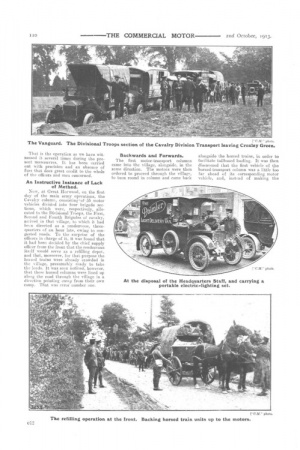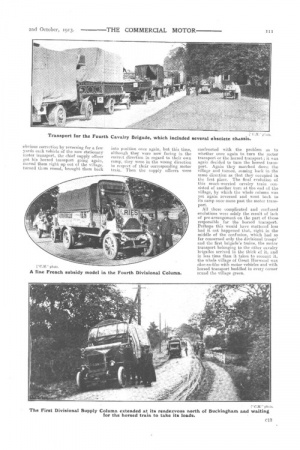That is the operation as we have witnessed it several
Page 16

Page 17

If you've noticed an error in this article please click here to report it so we can fix it.
times during the present manceuvres. It has been carried out with precision and an absence Of fuss that does great credit to the whole of the officers and men concerned.
An Instructive Instance of Lack of Method.
Now, at Great Durwood, on the first day of the main army operations, the Cavalry column, consisting of 35 _motor vehicles divided into four brigade sec• tions, which were, respectively, allocated to the Divisional Troops, the First, Second and Fourth Brigades of cavalry, arrived in that village, to which it had beta directed as a rendezvous, threequarters of an hour late, owing to congested roads. To the surprise of the officers in charge of it, it was found that it had been decided by the chief supply officer from the front that the rendezvous itself would serve as a refilling depot, and that, moreover, for that purpose the horsed trains were already crowded in the village, presumably ready to take the loads. It was soon noticed, however, that these horsed columns were lined up along the road through the village in a direction pointing away from their own camp. That was error number one.
Backwards and Forwards.
The first motor-transport columns came into the village, alongside, in the same direction. The motors were then ordered to proceed through the village, to turn round in column and come back alongside the horsed trains, in order to facilitate tailboard loading. It was then discovered that the first vehicle of the horsed-transport column was a little too far ahead of its corresponding motor vehicle, and, instead of making the
obvious correction by reversing for a few yards each vehicle of the now stationary motor transport, the chief supply officer got his horsed transport going again, moved them right up out of the village, turned them round, brought them back
into position once again, but this time, although they were now facing in the correct direction in regard to their own camp, they were in the wrong direction in respect of their corresponding motor train. Then the supply officers confronted with the problem as to whether once again to turn the motor transport or the horsed transport; it was again decided to turn the horsed transport. Again they marched down the village and turned, coming back in the same direction as that they occupied in the first place. The final evolution of this much-worried cavalry train consisted of another turn at the end of the village, by which the whole column was yet again reversed and went back to its camp once more past the motor transport.
All these complicated and confused evolutions were solely the result of lack of pre-arrangement on the part of those responsible for the horsed transport. Perhaps this would have mattered less had it not happened that, right in the middle of the confusion, which had so far concerned only the divisional troops' and the first brigade's trains, the motor transport belonging to the other cavalry brigades arrived in the thick of it, and in less time than it takes to recount it, the whole village of Great Harwood was awe-en-bloc with motor vehicles and with horsed transport huddled in every corner rcund the village green.


























